- Author Matthew Elmers [email protected].
- Public 2023-12-16 21:49.
- Last modified 2025-01-24 09:17.
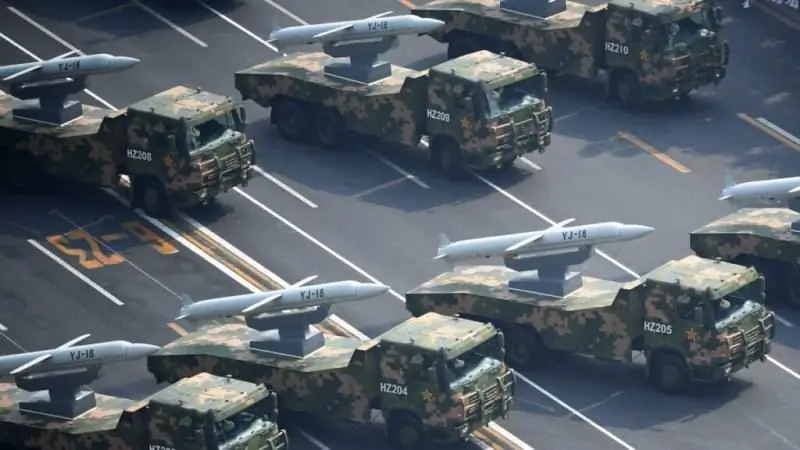
The PLA Navy has a wide range of missile weapons of different classes. Several types of cruise missiles are in operation at once, designed to attack surface or coastal targets. A few years ago, the list of such weapons was supplemented by the YJ-18 product, which was distinguished by increased tactical and technical characteristics and wider capabilities.
Modern weapons for the navy
From the available data, it follows that the development of the future Yingji-18 missile (Eagle Strike-18) and missile systems for it was launched no later than the end of the two thousandth years. In the first half of the last decade, the entire set of tests was carried out, after which the rocket and related means were recommended for adoption. According to foreign data, the operation of the YJ-18 began in 2015.
Chinese sources claim that the Yingji-18 project was created by China independently, based on the accumulated experience and available technologies. However, there are other versions as well. A few years ago, the Pentagon reported on the possible use of Russian developments. This explains a certain conceptual and technical similarity between the Chinese missile and Russian products of the "Caliber" family.
The PLA Navy has repeatedly demonstrated new weapons in parades and used them as part of exercises. Chinese and foreign sources report the presence of several variants of the missile system with different basing methods. At the same time, the tactical and technical characteristics have not yet been officially disclosed. However, the foreign press has long given estimates.
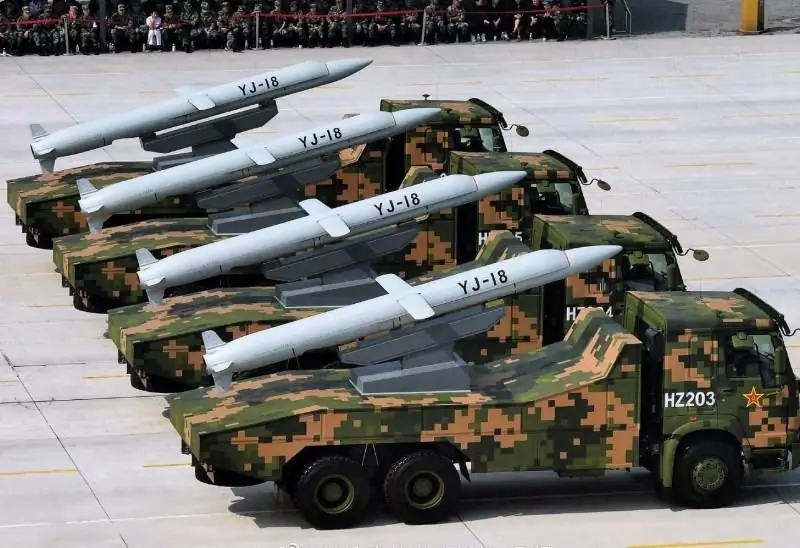
Technical look
Outwardly, the Chinese Yingji-18 missile hardly differs from other products of its class. In particular, it is similar to the Russian Caliber. Probably, it was the outward resemblance and the similar tactical role that led to the emergence of the version of the "Russian trace".
The Chinese rocket is made in a cylindrical body with a pointed nose fairing. The upper part of the body is complemented by a large gargrotto. It has a straight wing of low aspect ratio, which can be folded in flight. In the tail of the rocket there is a plumage with four planes. The exact dimensions and weights are unknown. At the same time, it was previously possible to compare missiles with automotive technology and determine their approximate dimensions.
The product layout is obvious. In the warhead, guidance and control equipment should be placed, the central compartment is given under the fuel tank and warhead. A turbojet engine is placed in the tail; its air intake is located on the bottom of the case.
According to the Chinese media, the Yingji-18 missile in its basic configuration is designed to attack targets with known coordinates. To do this, she uses inertial and satellite navigation. The following modifications of the product received active and passive radar seeker for destruction of moving or emitting targets.
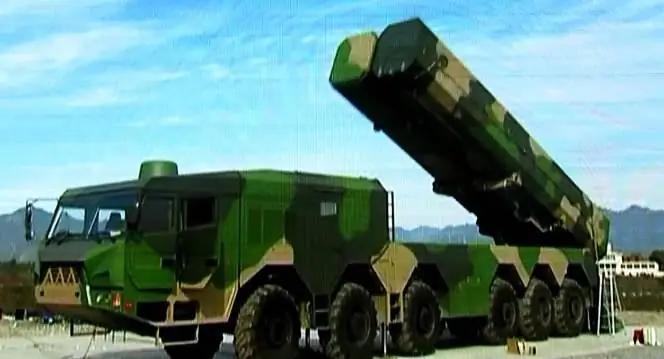
The missile carries a high-explosive or penetrating warhead. Its mass is estimated in a wide range - from 150 to 300 kg. This is enough to defeat ground targets of limited size, such as buildings or small clusters of equipment. An anti-ship missile modification with such a warhead is capable of inflicting fatal damage on corvettes and frigates; there is still a high danger for larger ships.
The YJ-18 missile is subsonic. It passes the main part of the trajectory at a speed of the order of M = 0.8 at low altitude. A height maneuver is carried out in front of the target, and at the end of the trajectory, the speed rises to M = 2 or more. Due to this, the impact on the target is enhanced, and interception is also made more difficult. Some sources claim that the missile warhead is made in the form of a separate stage with its own engine. She is capable of speeds up to 2, 5-3 M and fly at a distance of up to 35-40 km.
The range of the family's missiles has not been officially disclosed. According to foreign estimates, this parameter is within 500-540 km. Due to certain technical features, the submarine missile shows a slightly shorter range. Earlier it was reported about the possible creation of an aviation modification of the rocket, the range of which will be increased by dropping from a height.
Rocket carriers
The Yingji-18 missile of various modifications is used as part of several missile systems that differ in their capabilities. Some of these developments have already entered service with the PLA Navy, while others still exist only in the form of projects or prototypes. Perhaps, in the future, the scope of application of the multipurpose cruise missile will expand.
At parades of the recent past, YJ-18 missiles were demonstrated on transport vehicles. The missiles were shown without a transport and launch container, in flight configuration. Apparently, such "carriers" were created exclusively for demonstration events, but not for regular use in the troops.
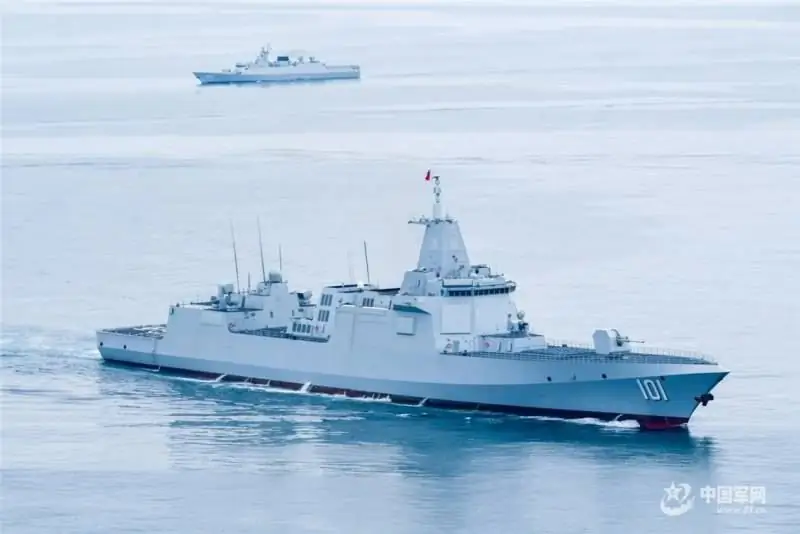
The basic modification of the Yingji-18 missile is intended to destroy stationary coastal targets. Its carriers are modern warships equipped with universal vertical launchers - destroyers of projects 052D and 055. The YJ-18A modification is anti-ship and is also intended for surface platforms.
The deployment of missiles of the YJ-18B version on submarines has been reported. Diesel-electric ships Type 039 and 039A are capable of carrying several of these missiles and launching them through standard 533-mm torpedo tubes. In foreign sources, it is assumed that the Yingji-18 can be used by Russian-built 877 and 636 submarines. Nuclear boats "Type 093" can use such weapons both with torpedo tubes and with separate vertical installations.
A prototype of a coastal missile system was demonstrated several years ago. The launcher was carried out on a six-axle chassis and equipped with an arrow for two anti-ship missiles in the TPK. Whether this project has been developed is unknown. The adoption of such a complex for service was not reported. A container modification of the complex was also proposed, suitable for placement on various ships and vessels. So far, it has been shown only in the form of advertising materials. There are rumors about the possible creation of an aircraft-based modification, but they have not yet been confirmed.
Missile potential
Thus, China, following other developed countries, has developed its own multi-purpose subsonic cruise missile for use on different platforms. Foreign experience of recent decades clearly shows the potential and convenience of such weapons - and the PLA Navy did not ignore the promising concept. It has already been implemented in the form of modern missiles for ships and submarines, and in the future it is possible to deploy the complexes on other platforms.

The Yingji-18 missile is of great importance to the Chinese fleet. This product is compatible with today's major ship and submarine types for ease of deployment and future proofing. The ability to engage various targets at ranges of at least 500 km makes the missile a convenient tool for solving a wide range of tasks of an attack or defensive nature.
The potential of the rocket in combination with the capabilities of the standard launch vehicles looks even more interesting. Destroyers or submarines of new projects make it possible to move the launch lines into the distant sea zone - and thereby warn the enemy's naval forces from approaching the Chinese shores.
For obvious reasons, foreign experts are more interested and worried about the offensive potential of Eagle Strike-18. In recent days, a number of publications have appeared in the foreign press on the topic of the hypothetical use of modern ships with YJ-18 in the war for Taiwan or for the disputed islands. Based on the known data, conclusions are drawn according to which this missile seriously increases the strike potential of the PLA Navy and, accordingly, their danger to the fleet of a potential enemy.
Development ways
Being a versatile weapon with broad capabilities, the Yingji-18 cruise missiles are in theory capable of replacing several existing models at once. It is quite possible that these opportunities will be used in the further development of the fleet. As the ship's composition is updated, the share of YJ-18 in missile armaments of surface and submarine forces will grow. In addition, coastal and aviation missile systems can be brought into operation.
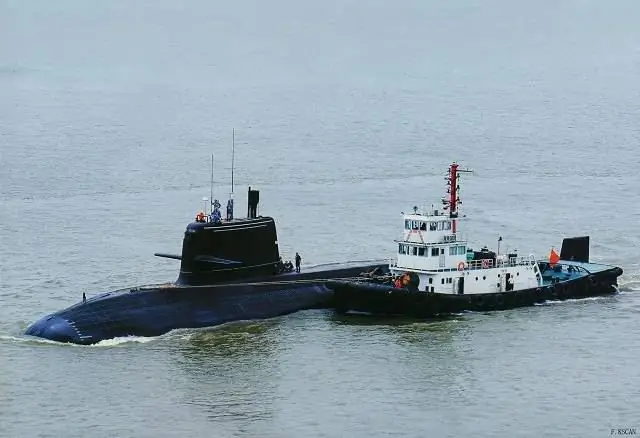
It is obvious that the development of the PLA Navy will be carried out not only through the supply and deployment of missiles of a new family. In particular, we should expect the emergence of new reconnaissance and control means, due to which the effectiveness of the combat use of missiles, and not only the YJ-18 and regardless of the basing method, will increase.
Thus, by now, the Yingji-18 family of cruise missiles has confirmed its potential and has taken its rightful place in the PLA's naval arms structure. This state of affairs will persist and develop for a fairly long time - and give understandable positive consequences in the context of the capabilities of the fleet and national security.






